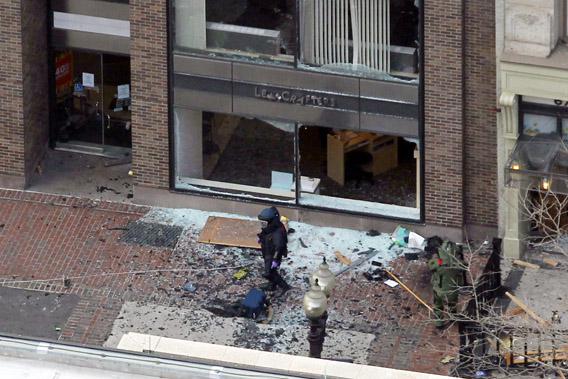In the aftermath of yesterday’s bombing at the Boston Marathon, investigators are working a 12-block crime scene to determine what kind of bomb was used and what kind of bomber—domestic or international—planned the attack. What sort of forensic evidence do explosions leave behind?
Bomb fragments, residue from the explosive, bits of electronics, and sometimes even the bombers’ own fingerprints and DNA. One of the first things investigators do at a bombing site is determine what kind of explosive was used. There are a few ways to do this. For example, forensic scientists can use a handheld ion mobility spectrometer to sniff the air around the blast for traces of the explosives. (This is similar to what’s used by the Transportation Security Administration if they ask you to step into a puffer machine.) Some of these devices can identify the specific type of explosive in the air, which is named in a digital readout. Other investigators may run color tests, in which bomb residues are applied with solutions containing reagents that change color in response to specific explosives. Both of these tests are considered presumptive and can be confirmed with procedures like chromatography and mass spectrometry back at the lab.
If the explosive is unusual, investigators may be able to determine where it was purchased. For example, some explosives are tagged with chemical markers, called taggants, that identify where they came from. If the explosive, on the other hand, is TNT, you know it was probably stolen, and you can look over the mandatory theft reports filed to the Bureau of Alcohol, Tobacco, Firearms and Explosives, which requires photo ID for all purchases. (These thefts are reported many times a year, but investigators may be able to incorporate evidence connected with the thefts into the bombing investigation.) Unfortunately, if the explosive is homemade from common ingredients, such as fertilizer or gun powder, then the chemicals are difficult to trace.
Investigators also collect bomb fragments from throughout the blast area—and in horrible cases like the Boston bombings, from the victims—in order to try to reassemble the bomb. Once they have an idea of what the device looked like, they can cross-reference it with the FBI’s Terrorist Explosive Device Analytical Center database, which collects all the improvised explosive devices used by terrorists abroad. Individual groups tend to have their own signature ways of making IEDs, using similar materials and designs, and the FBI may be able to match the device with a pre-existing series of devices in its database.
More-powerful bombs with softer casings tend to leave smaller fragments, while bombs with harder casings, such as pipe bombs made of steel, can leave fragments several inches long. If just the cap of the pipe bomb flies off, investigators may find the whole pipe. However, even small fragments on their own can be useful to investigators. For example, in the case of Pan Am Flight 103, a fragment of a circuit board that investigators say they found in a scorched shirt proved to be a crucial piece of evidence. Investigators may also try to determine the origins of individual components, such as by determining the model of watch used as a timer, or even the specific brand of glue or electrical tape used to hold them bomb together.
If investigators are able to collect large enough fragments, they are sometimes able to collect residual fingerprints or DNA evidence. One way to detect and preserve fingerprints is through “superglue fuming”: In this technique, you heat superglue in a closed container with the piece of evidence, and the superglue gathers around the fingerprint, highlighting and preserving it. This is because superglue bonds remarkably well to the sweat and residue on human fingers (which is also why it’s easy to get your fingers stuck together when handling superglue). On IEDs, however, fingerprints are usually burned off any fragments, so investigators will look for DNA. This may include “touch DNA”: just touching something can leave dead skin cells behind, especially if the surface is rough.
While these are most of the principal techniques investigators use to gather clues at the crime scene, they’re not the only ones. For example, if the bomber leaves a bag or backpack, an investigator might inspect it for trace elements such as pollen or pet hair. Pollen can be traced back to specific types of flowers, and forensic botanists can cross-reference these flowers against each other to determine where the bomber might have been. Pet hair can be used to determine, for example, whether the bomber owns a specific breed of dog. Once a suspect is identified, all of this evidence can be used to search his or her home for matches.
Also read L.V. Anderson on how police do controlled detonations.
Read more on Slate about the Boston Marathon bombing.
Got a question about today’s news? Ask the Explainer.
Explainer thanks David Foran of Michigan State University, John Goodpaster of Indiana University–Purdue University Indianapolis, and Glen Jackson of West Virginia University.
